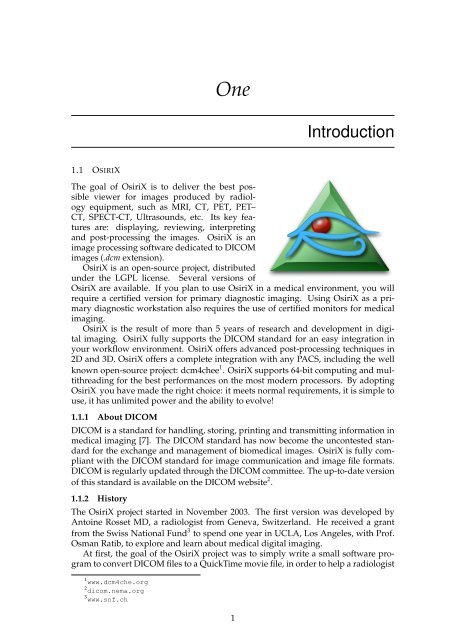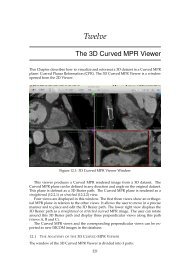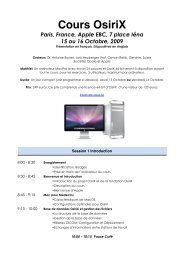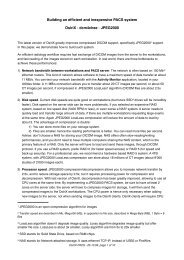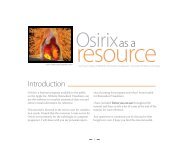Create successful ePaper yourself
Turn your PDF publications into a flip-book with our unique Google optimized e-Paper software.
1.1 OSIRIX<br />
One<br />
Introduction<br />
The goal of <strong>OsiriX</strong> is to deliver the best possible<br />
viewer for images produced by radiology<br />
equipment, such as MRI, CT, PET, PET–<br />
CT, SPECT-CT, Ultrasounds, etc. Its key features<br />
are: displaying, reviewing, interpreting<br />
and post-processing the images. <strong>OsiriX</strong> is an<br />
image processing software dedicated to DICOM<br />
images (.dcm extension).<br />
<strong>OsiriX</strong> is an open-source project, distributed<br />
under the LGPL license. Several versions of<br />
<strong>OsiriX</strong> are available. If you plan to use <strong>OsiriX</strong> in a medical environment, you will<br />
require a certified version for primary diagnostic imaging. Using <strong>OsiriX</strong> as a primary<br />
diagnostic workstation also requires the use of certified monitors for medical<br />
imaging.<br />
<strong>OsiriX</strong> is the result of more than 5 years of research and development in digital<br />
imaging. <strong>OsiriX</strong> fully supports the DICOM standard for an easy integration in<br />
your workflow environment. <strong>OsiriX</strong> offers advanced post-processing techniques in<br />
2D and 3D. <strong>OsiriX</strong> offers a complete integration with any PACS, including the well<br />
known open-source project: dcm4chee 1 . <strong>OsiriX</strong> supports 64-bit computing and multithreading<br />
for the best performances on the most modern processors. By adopting<br />
<strong>OsiriX</strong> you have made the right choice: it meets normal requirements, it is simple to<br />
use, it has unlimited power and the ability to evolve!<br />
1.1.1 About DICOM<br />
DICOM is a standard for handling, storing, printing and transmitting information in<br />
medical imaging [7]. The DICOM standard has now become the uncontested standard<br />
for the exchange and management of biomedical images. <strong>OsiriX</strong> is fully compliant<br />
with the DICOM standard for image communication and image file formats.<br />
DICOM is regularly updated through the DICOM committee. The up-to-date version<br />
of this standard is available on the DICOM website 2 .<br />
1.1.2 <strong>History</strong><br />
The <strong>OsiriX</strong> project started in November 2003. The first version was developed by<br />
Antoine Rosset MD, a radiologist from Geneva, Switzerland. He received a grant<br />
from the Swiss National Fund 3 to spend one year in UCLA, Los Angeles, with Prof.<br />
Osman Ratib, to explore and learn about medical digital imaging.<br />
At first, the goal of the <strong>OsiriX</strong> project was to simply write a small software program<br />
to convert DICOM files to a QuickTime movie file, in order to help a radiologist<br />
1 www.dcm4che.org<br />
2 dicom.nema.org<br />
3 www.snf.ch<br />
1
2 CHAPTER 1. INTRODUCTION<br />
friend, Luca Spadola MD, to create a teaching files database. He spent more than two<br />
weeks searching a Java library for DICOM management and image manipulation.<br />
Indeed he wanted to create a cross-platform software program for Windows, Mac OS<br />
and Linux. But at that time, Apple had just released Mac OS X 10.3, the first usable<br />
release of their UNIX-based OS. It became obvious that Mac OS X was the best choice<br />
to quickly create a robust and modern DICOM viewer:<br />
One DICOM viewer to rule them all<br />
This small project became the unique obsession of this young radiologist. A<br />
SourceForge account 4 was created in January 2004 to develop <strong>OsiriX</strong> as an LGPL<br />
software.<br />
The first public version was released in April 2004, version 0.1a, on Antoine Rosset’s<br />
personal homepage 5 . This first version was developed in less than 6 months: it<br />
offered a basic database and a simple DICOM viewer, without post-processing functions<br />
or measurement tools.<br />
In October 2004, Antoine Rosset went back to the Geneva University Hospital in<br />
Switzerland, to continue his career as a radiologist, but his obsession with <strong>OsiriX</strong><br />
remained strong.<br />
The reference article about the <strong>OsiriX</strong> project was written in April 2004 and published<br />
in June 2004 in the Journal of Digital Imaging [10].<br />
Joris Heuberger, a mathematician from Geneva, joined the project in March 2005<br />
on a voluntary fellowship of 6 months in UCLA, Los Angeles. During this period,<br />
while working on plugins for <strong>OsiriX</strong>, he added the first Fly Through algorithm to the<br />
Surface Rendering and Volume Rendering viewers.<br />
In June 2005, during Apple’s Worldwide Developer Conference (WWDC) in San<br />
Francisco, <strong>OsiriX</strong> received two prestigious Apple Design Awards: Best Use of Open<br />
Source and Best Mac OS X Scientific Computing Solution (Figure 1.1).<br />
Figure 1.1: The two prestigious Apple Design Awards<br />
Osman Ratib, Professor of Radiology in UCLA, returned to Geneva at the end of<br />
2005 as the chairman of the Nuclear Medicine service. He was the first and unconditional<br />
supporter of the <strong>OsiriX</strong> project. Thanks to his commitment, <strong>OsiriX</strong> became<br />
4 www.sourceforge.net/projects/osirix/<br />
5 homepage.mac.com/rossetantoine/osirix/
1.1. OSIRIX 3<br />
the official DICOM viewer for the Radiology Department of the Geneva University<br />
Hospital in 2009.<br />
At this time, Antoine Rosset and Joris Heuberger became the core team of <strong>OsiriX</strong><br />
software. Over the years, <strong>OsiriX</strong> has benefitted from many external contributors. The<br />
most active external contributor was Lance Pysher MD, a US radiologist. He notably<br />
added the foundation for the DICOM Network protocol, through the DCMTK library<br />
(Offis) and wrote an Objective-C framework for DICOM files management (DCM<br />
Framework).<br />
In March 2009, Antoine Rosset, Joris Heuberger and Osman Ratib created the<br />
<strong>OsiriX</strong> Foundation 6 to promote open-source in medicine. This non-profit foundation<br />
offers grants to students for developing open-source software in medicine. The foundation<br />
also organizes awards with prizes to stimulate development in digital imaging<br />
and post-processing. Most of these projects are based around <strong>OsiriX</strong>.<br />
Figure 1.2: From left to right: Osman Ratib, Joris Heuberger and Antoine Rosset<br />
In February 2010, Antoine Rosset and Joris Heuberger created the company<br />
Pixmeo 7 to continue to promote open-source solutions in medical imaging, including<br />
<strong>OsiriX</strong> development. The major goal of this company is to certify <strong>OsiriX</strong> as a<br />
FDA cleared product and offer commercial support for open-source solutions, such<br />
as <strong>OsiriX</strong> or dcm4chee.<br />
Today, Antoine Rosset is working as a radiologist in La Tour 8 private hospital.<br />
Joris Heuberger is working as a Mac OS and iOS developer.<br />
Their commitment to the <strong>OsiriX</strong> project is intact, thanks to the support of more<br />
than 40,000 users throughout the world. From a student project, <strong>OsiriX</strong> is today a<br />
mature and professional project, benefiting from experienced developers and users<br />
and used by thousand of institutions, including the most prestigious medical centers.<br />
6 www.osirixfoundation.com<br />
7 www.pixmeo.com<br />
8 www.latour.ch


